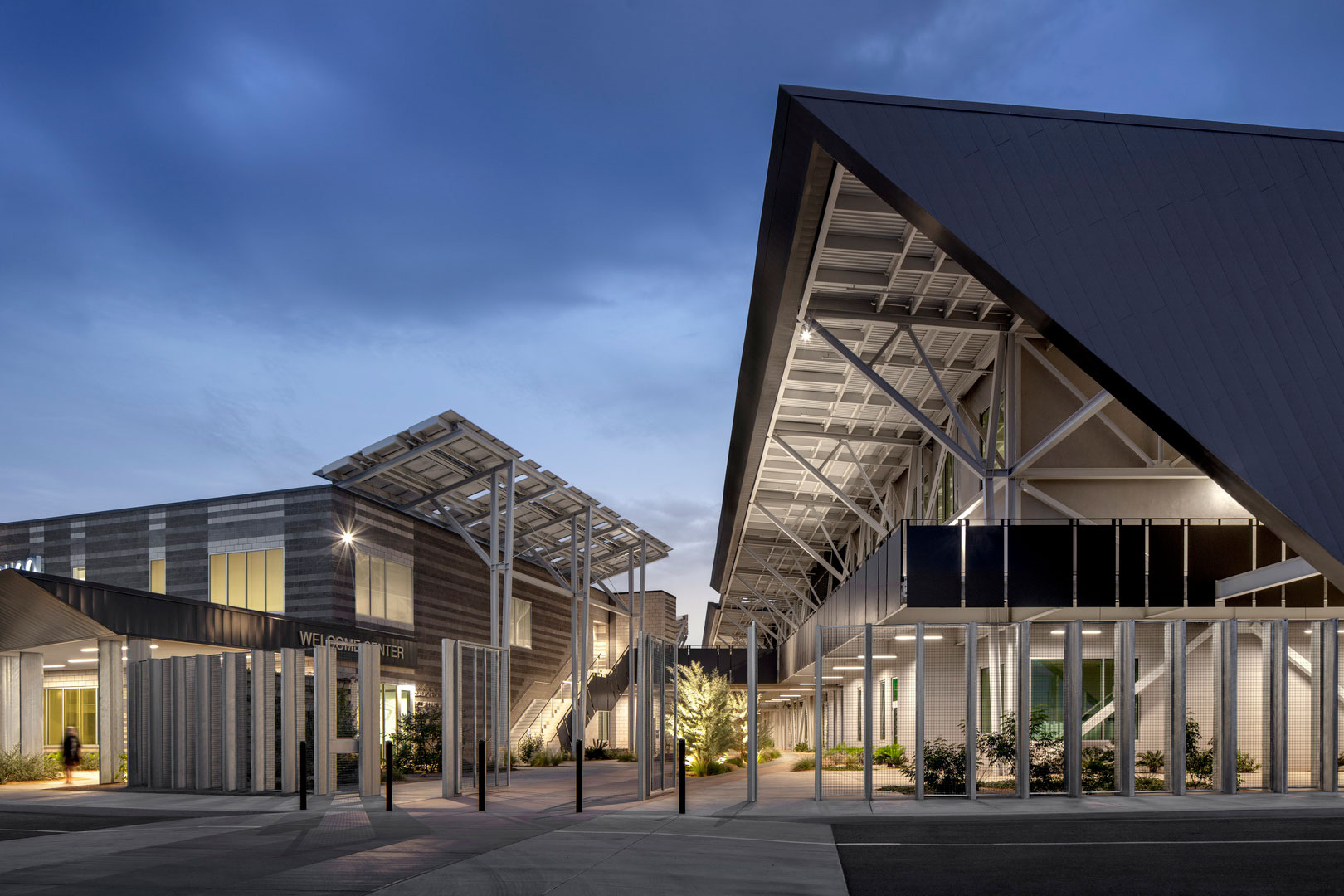Story at a glance:
- Designing for school safety is about more than security and violence prevention, though that’s part of it.
- DLR Group’s commitment to designing safe schools starts by making sure the buildings integrate well with the community.
- The architects look at how school design can be healthy, too, with indoor/outdoor settings like at Canyon View High School.
Designing safe school spaces is not just about preventing school shootings, though that’s part of it. At DLR Group, designing a K-12 facility with safety in mind starts by making places where students feel like they belong.
“I’m not a big fan of talking about safety as safety,” says Todd Ferking, principal at DLR Group. Ferking has been with the firm for more than 20 years and is currently the National K-12 Education Design Leader, overseeing all K-12 design. “When we’re defining what type of spaces go into a building—how big they are, how they’re going to be grouped—we talk about the foundations of good learning. Not only do relationships help support students in achievement, but they also make them safer.”
Asking Questions
The architects start by asking questions that aim to get at the heart of the school’s mission. “What do you want to achieve? What are your values? What’s the culture of the school?” Ferking asks. “That informs how the building gets laid out. We rarely come in and say, ‘What do you want in your classroom?’ Really we’re asking, ‘How do you want to engage students?’” Designing to create a place where students feel like they belong not only celebrates the students—building in something like a student display of work, for example—it’s also a safety strategy at the end of the day.
DLR Group looks to create a sense of identity and belonging in each of their designs, whether it’s the innovative, indoor/outdoor setup that is Canyon View High School in Arizona or the large centralized kindergarten in Washington.
“I often think about this almost like Maslow’s hierarchy of needs. We’re fulfilling those base layers of needs—nutrition, good air quality, thermal comfort—and then there’s this layer of feeling safe,” Ferking says. “To get to the top of this pyramid, which is the ultimate goal of education—self-actualization, self-empowerment—we start those conversations really early. While they’re not explicitly framed around safety, they are in a way.”
Ferking says those conversations ask everything from “How do we manage scale?” to “What types of programs are going to be offered?” “In indirect ways we’re always talking about safety because all of those factors contribute to a kid acting out,” he says, adding that perhaps some of these unseen design elements can help mitigate the risk of violence.
Designing Health & Happiness
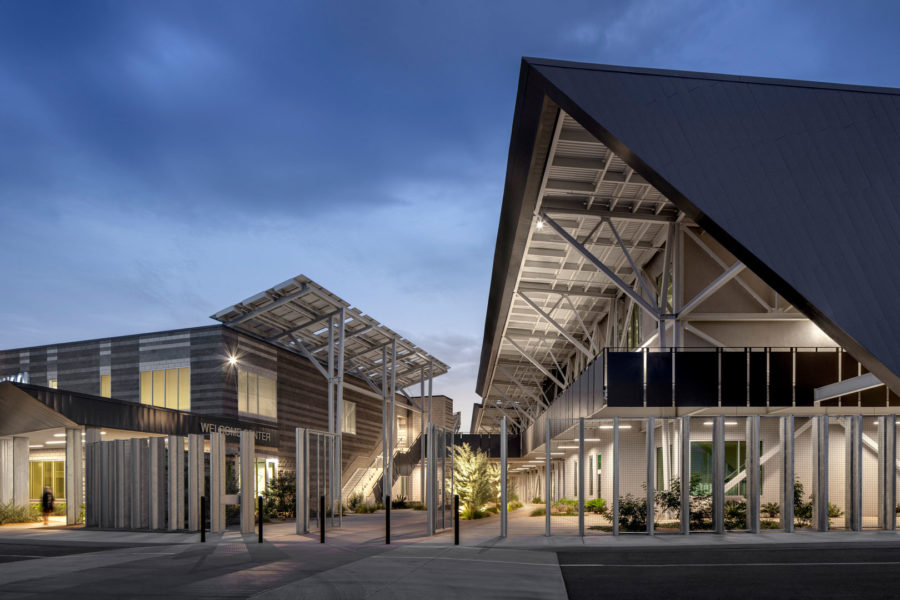
The exterior of Canyon View High School in Arizona, designed by DLR Group. Photo by Bill Timmerman
DLR Group has a K-12 ethos that’s built on a holistic approach to health and well-being, including physical, social, and emotional health. “Safety is under that umbrella, really thinking about the student and educators in a holistic way and how the building can promote health,” Ferking says.
Engagement continues to be a big part of the discussion. Ferking says DLR Group strives to design to build community—not only within the school itself but in relation to its surroundings. “How a school fits within a larger community is also part of the safety conversation,” he says. “Really engaging the families and the neighbors into a shared ownership of the place, so it’s valued and protected.”
With the pandemic also came concerns around indoor air quality and reduction in virus transmission. Covid triggered awareness around IAQ and turned up some interesting research, as air quality significantly affects cognitive function, according to a Harvard study. “Indoor air quality has a direct benefit to schools; it will potentially improve student performance just through improving the air quality,” Ferking says.
He said the study showed a direct correlation between the volume of outside air coming into a space and cognitive capacity. “If you put twice as much natural air into a space it nearly doubles cognitive function,” he says.
Design for Belonging
While incidents of school violence have been tragically common over the past 25 years, Ferking says architects not only have a high awareness, but are taking a more comprehensive, creative approach to safety that goes beyond “How do we control access?”
When it comes to violence in schools, he says most is seen at the upper grade levels and comes from students within the school—not from an outside shooter. It’s often someone who’s part of the school community. DLR Group looks at what might influence that and how it might be prevented. “That begins a conversation around making sure every student feels known, that there are relationships formed,” he says.
That also influences how architects break down a building’s scale, Ferking says, making sure every student has a connection with an adult in the building. They consider how to break down larger high schools with thousands of students—and how to design so students don’t get lost in the shuffle. “That’s probably the biggest shift,” he says. “And we’re talking a lot more about social and emotional health these days and mental health issues, especially in the pandemic. Kids have a lot of anxiety and stress coming from very different home life circumstances. A lot of kids are entering school with trauma, so trauma-informed design is really coming into the fore as we talk about school design.”
Transparency & Flexibility
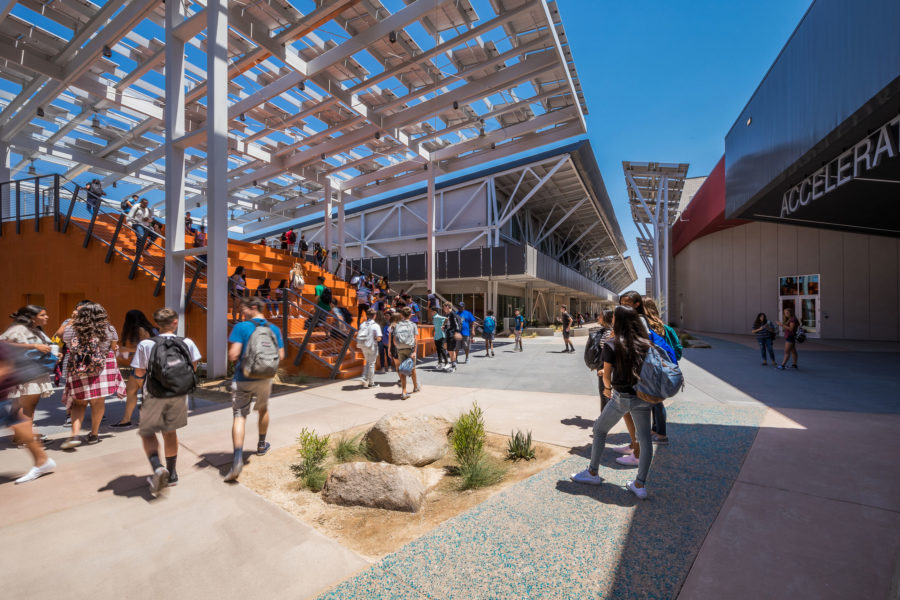
Canyon View High School, designed by DLR Group, is a series of interconnected buildings that include indoor and outdoor project rooms, a learning stair, student dining, and an athletic training corridor to take advantage of the mild southwestern climate. Photo by Tom Reich
Canyon View High School in Arizona is a beautiful example of a DLR Group project that manages scale while giving students and teachers a feeling of ownership and pride. The school is designed using forts—essentially suites of interconnected learning spaces that were designed to conjure childhood memories of building forts with chairs and sheets. “These are highly flexible learning suites that have a variety of environments in them, so they’re not your not typical ‘cells and bells,’” Ferking says.
Rather than cells and bells—or the common double loaded corridor classrooms and “one size fits all” type of environments—the forts are flexible and easy to personalize. They can be connected to one another or stand alone, or easily resized for a small group, a one-on-one meeting, a large group, or nearly any other configuration. Ferking says the flexibility and engagement of the environment itself moves toward giving students a real sense of place. “They feel engaged, and the space is dynamic and ever-evolving. Part of that is that idea around safety.”
Teamwork Approach
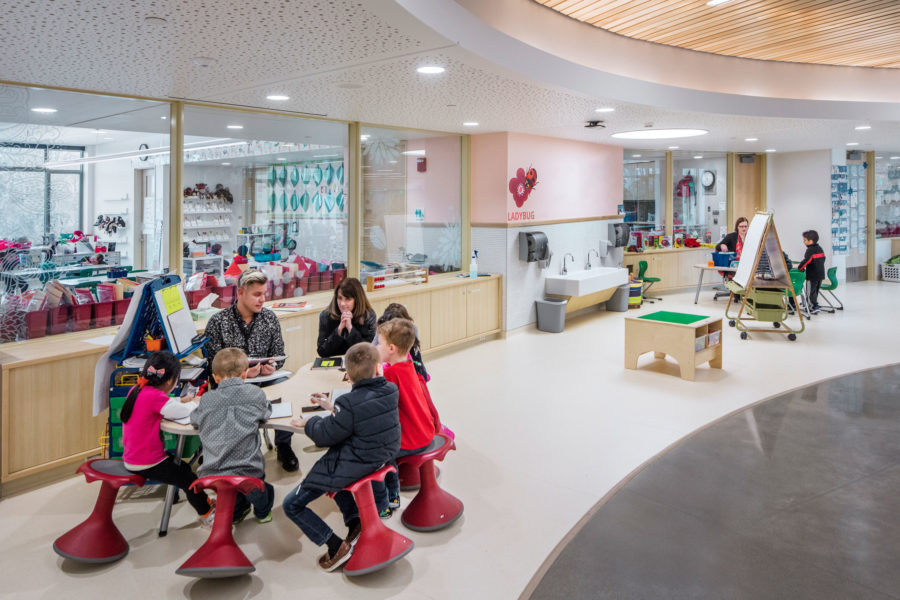
Inside Pathfinder Kindergarten Center in Washington. Photo by Chris Roberts
Educators at Canyon View work as a team, moving across suites instead of teaching in one room. “They’re intentionally moving the educators around that environment so the educational strategies don’t become static,” Ferking says.
He says this allows teachers to collaborate more than they would in a traditional school model. “They are working as a collective to support these students, so if they identify challenges a student is having—whether it’s behavioral or a circumstance at home—they as a team can begin to address that. The more we can get the adults in the building working together as a unit versus in their silos in a traditional model, the easier I think it is to identify kids in distress.”
Canyon View is also remarkably transparent, in that it’s a series of interconnected buildings that include indoor and outdoor project rooms. Outdoor learning spaces were engineered for the hot Arizona climate, emphasizing strategies around shade, plants, areas of humidity, and fans to create a comfortable space. “When you’re in the campus it feels very open, but there are definite layers of security,” Ferking says. “We definitely employed CPTED principles—looking for sight lines, thinking about visibility and what areas can you supervise? What are your points of access?”
CPTED, or Crime Prevention Through Environmental Design, emphasizes natural surveillance, access control, territorial reinforcement, and space management among its main principles to help create safe environments that encourage activity and vitality.
“The goal is that safety considerations are transparent or invisible. Our biggest goal is to not create a fortress that looks like a fortress. That sends a different message and ultimately creates a layer of stress just by having that kind of environment. The more those conditions are transparent the better,” Ferking says.
Safety You Don’t See

DLR Group designed Pathfinder to have a pod system. Photo by Chris Roberts
When the State of Washington moved kindergarten from half-day to full day instruction, public schools suddenly had to accommodate a lot more kindergarten programs. Instead of adding on to every elementary school, the Mulkiteo School District in Everett created a central center for 600 kindergarteners from all over the district. The Pathfinder Kindergarten Center sounded intense at first—is that too many children?—and while Ferking initially questioned it, too, he saw the benefits of it in action.
Similar to every project they do, DLR Group began by looking at how they could break down scale. In this case, they created four almost entirely self-contained kindergarten suites with about 150 kids. “We pushed everything into the kids,” Ferking says. There is no centralized dining hall; dining is in each learning suite. All of the specialists push into the suites and work directly with educators and students. And Ferking says families also feel more connected as they have their own parents’ lounge.
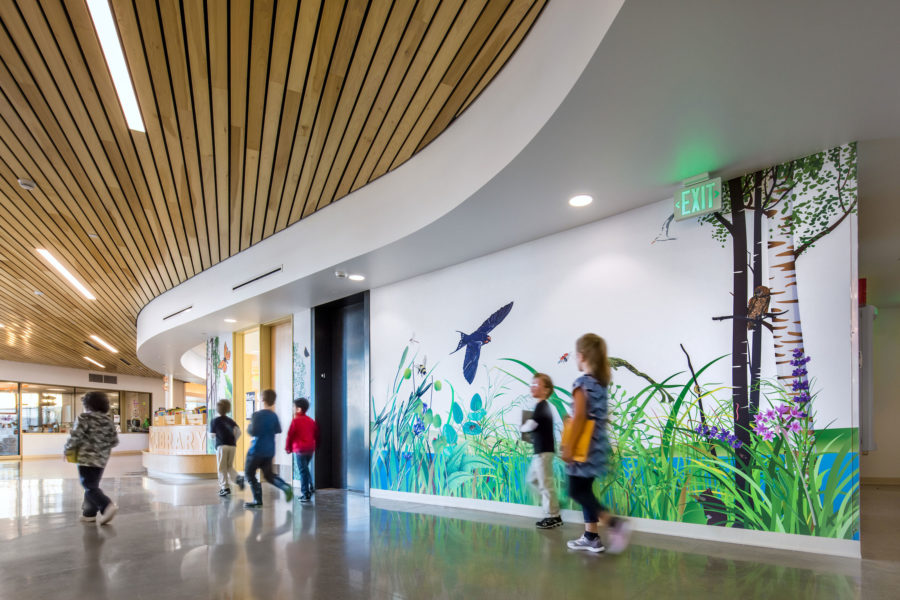
When compared to traditional early education learning environments, where students move to the services they need, Pathfinder reduces transition times by 60%. Over the course of one year, that gives students nearly one additional week of learning time. Photo by Chris Roberts
Given its significant effect on learning, indoor environmental quality also received diligent design attention in the areas of temperature, air quality, daylighting, and acoustics. With the kindergarten students spending a lot of time learning on the floor, heat is provided by radiant floors sourced from a geothermal ground-source heat pump. When compared to traditional early education learning environments, where students move to the services they need, Pathfinder’s pod system has proven to reduce transition times by 60%. Over the course of one year, that gives students nearly one additional week of learning time.
As for safety, the building is designed like an onion with many layers. There’s a secure vestibule and only one way into the building. “Pathfinder has the ability to compartmentalize and secure the learning areas from the rest of the building,” Ferking says. “It essentially breaks into five separate secured areas with the push of a button.” It’s an added layer of security you wouldn’t even know was there until the doors close. “One of the biggest things in a shooting event is to slow the event down. Those first few minutes are crucial.”

